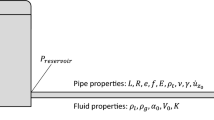Abstract
Transient analysis for compressible fluid flow has been conducted to evaluate the dynamic characteristics of the dead-ended or volume-terminated transmission lines following a sudden pressure change at its entrance. The two partial-differential equations, based on the conservation of mass, energy and momentum, were derived for the one-dimensional adiabatic compressible flow with friction and entrance head loss. The governing equations describing the present transient-state flow are hyperbolic, and the boundary conditions include a fixed volume termination at the exit and sinusoidal disturbance in the sudden pressure change at tube entrance. The method of characteristics is used to transform the partial differential equation into the particular total differential equations, which can be integrated along the characteristic lines. The present result shows good agreements with the existing results. The effects of tube length. tube diameter and end volume are evaluated on the responses of the pressure and on the damping factor.
Similar content being viewed by others
Abbreviations
- A :
-
Cross section area of the pipe
- c :
-
Acoustic velocity
- C c :
-
Critical damping coefficient
- C k :
-
Coefficient of entrance loss
- D :
-
Pipe diameter
- f :
-
Friction factor
- g :
-
Acceleration of gravity
- H :
-
Pressure head
- k :
-
Fluid-elastic stiffness coefficient
- L :
-
Pipe length
- m :
-
Effective mass of fluid in the pipe
- p :
-
Pressure
- Q :
-
Flow rate
- Re :
-
Reynolds number
- t :
-
Time
- T :
-
Period of oscillation
- u :
-
Mean flow velocity
- V q :
-
Fixed volume of the receiver
- x :
-
Axial coordinate
- ζ:
-
Damping factor
- μ:
-
Viscosity of fluid
- ρ:
-
Density of fluid
- ω:
-
Circular frequency
- +:
-
Nondimensional parameter
- a :
-
Based on acoustic velocity
- e :
-
Entrance
- t :
-
Based on lumped acoustic element method
- mean :
-
Mean value
- res :
-
Sending reservoir
- rt :
-
Receiver
- s :
-
Static step input
References
Abbott, M. B., 1966, “An Introduction to the Method of Characteristics,”American Elsevier, New York.
Bradner, M., 1949, “Pneumatic Transmission Lag,”Instruments, Vol. 22, pp. 618–625.
Bulaty, T. and Niessner, 1985, “Calculation of 1-D Unsteady Flows in Pipe Systems of I. C. Engine,”Journal of Fluids Engineering, Vol. 107, pp. 407–412.
Chaudhry, M. H., 1987, “Applied Hydraulic Transients,”Van Nostrand Reinhold, 2nd ed., New York.
Evangelisti, G, 1969, “Waterhammer Analysis by the Method of Characteristics,”L’Energia Electrica, Nos. 10-12, pp. 673–692, 759–770, 839–858.
Holloway, M. B. and Chaudhry, M. H., 1985, “Stability and Accuracy of Waterhammer Analysis,”Advances in Water Resources, Vol. 8, pp. 121–128.
Iberall, A. S., 1950, “Attenuation of Oscillatory Pressures in Instrument Lines,”Journal of Research of the National Bureau of Standards, Research Paper RP2115, Vol. 45, pp. 85–108.
Kinsler, L. E., Frey, A. S., Coppens, A. B. and Sanders, J. V., 1982, “Fundamentals of Acoustics,” John Wiley & Sons, 3rd ed., New York.
Moise, J. C., 1954, “Pneumatic Transmission Lines,”Journal of the ISA, Vol. 1, pp. 35–40.
Rohmann, C. P. and Grogan, E. C., 1957, “On the Dynamics of Pneumatic Transmission Lines,”Trans. ASME, Vol. 79, pp. 853–867.
Sabersky, R. H, Acosta, A. J. and Hauptmann, E. G., 1971, “Fluid Flow,” Macmillan Co., 2nd ed., New York.
Schuder, C. B. and Binder, R. C., 1959, “The Response of Pneumatic Transmission Lines to Step Inputs,”Journal of Basic Engineering, Vol. 81, pp. 578–584.
Wiggert, D. C., Otwell, R. S. and Hatfield, F. J., 1985, “The Effect of Elbow Restraint on Pressure Transients,”Journal of Fluids Engineering, Vol. 107, pp. 403–406.
Author information
Authors and Affiliations
Rights and permissions
About this article
Cite this article
Sim, WG., Park, JH. Transient analysis for compressible fluid flow in transmission line by the method of characteristics. KSME International Journal 11, 173–185 (1997). https://doi.org/10.1007/BF02944891
Received:
Issue Date:
DOI: https://doi.org/10.1007/BF02944891




